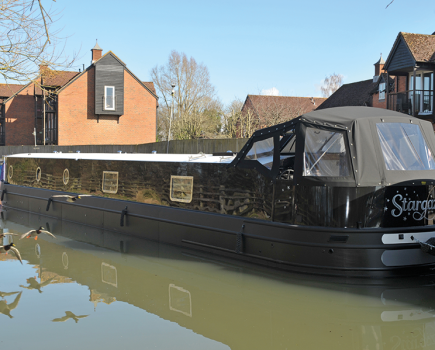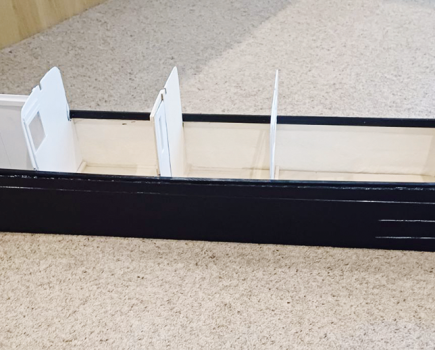Text and pictures by Helena Lightbody
As a boater of two decades or so I would pitch my competency, on the general scale of beginner to expert, somewhere in the middle. I do realise that this seems really rather low with 20 years of boating experience to draw on, but I defend myself by writing some of that time off to toddling and adolescence. Nonetheless, not being at the novice end of the scale, I wondered whether signing up to the Inland Waterways Helmsman’s Course would be helpful to me, and how much I would learn.
The team at Willow Wren, where I was taking the course, send out the handbook a couple of weeks in advance, so I was able to read the outline of what I would learn. Looking through, I began to think “well I can do most of that already”; having been on the water for a while a lot of it seemed like common sense. I almost wondered whether I would be advised not to jump a five-foot gap with a four-foot rope.
But then I, perhaps like many other boaters, often have at the back of my mind a nagging worry of whether I am actually doing it right: maybe I am missing out on some technique for never-ever bashing into a lock gate, however tight the approaching bend, that only the real gurus know about. And, as I flicked further through the booklet, I was confronted with little diagrams of how to neatly parallel moor a narrowboat. Is this more complicated than ‘bows in, stern in’? I wondered. Perhaps my family and friends have been putting up with inelegant mooring for years and just not wanted to say anything. So with the prospect of rectifying this, and looking forward to learning about helming a craft from an expert, and with the belief that every boater has something to learn, I set off for Rugby to have a day with Steve of Willow Wren.
As it turned out I was the only person signed up for the course that day and so Steve was skilfully able to tailor the day to my level of experience. Knowing that I was writing up the course for Canal Boat he also explained very well how it would work with more people, and perhaps most importantly, how he runs a course with people of mixed abilities. The maximum number of people they take out on a day course is three, because beyond that, the practical element of the learning experience understandably gets diluted. But, in fact, taking a course with three people is much better than one, he says, and normally if people request to have one-to-one tuition, he explains the very real advantage of learning boating skills with other people.
The idea would normally be that, of the three people, one would be steering, another observing, and another would be ‘crew’. This means that not only does everyone get a chance to steer, but also practice in telling people where to be (“could you take a line off from the bows please”) and how they can help you. If you are taking the course as a boat owner, think of the number of non-boaty guests you have cruised with in the past – part of this course is to help you explain clearly and concisely to an inexperienced crew member how best they can help you out. You would also get the experience of being crew for someone else, and when you have a chance to observe you would be able to have a think about the skills being taught, and often watching someone else pick up practical skills can help you both learn.
With a group of mixed ability the idea of each person getting time at the helm means that each person can work at whatever level they are at: the more experienced and confident helmsman can work on the nifty no-bump parallel moor (less complicated than it looked in the diagrams, but still a nifty little skill) and the novice boater can get a good amount of time building up confidence on basic manoeuvres.
As it was, I spent most of the day at the helm. As an instructor Steve says that he never unnecessarily takes the tiller, partly because the best way to learn is by doing, but also because many of the people who come on the course need a confidence boost, and there is nothing worse than an agitated instructor saying “I’ll just take over for a second, you were looking a bit close there” when actually they were doing perfectly fine. He was able to be my ‘crew’ as well, so practising mooring and lock technique also gave me a chance to think about where he would be most helpful, and to remember to remind him to pull up the fenders. I found this particularly useful as, on the few occasions when I’ve been the most experienced boater on a trip, I haven’t always been confident enough to tell people what to do. The course did honestly make me realise that people want to be told!
There was a small theoretical part to the day as well, but having been intimidated by the use of the word ‘classroom’ I needn’t have worried, even the theory was really very practical – we worked on knot-tying and line-throwing. I learned the canalman’s hitch, but having used a clove hitch for absolutely every situation ever I wonder how easy it will be to change my habits. The canalman’s is MUCH easier to undo if the line has been pulled taut, but stick to the clove hitch on a mooring spike, in case it gets pulled out of the ground and into the cut. And having spent years chucking a rope at the bank and hoping it makes it, much like a wild throw at the stumps from the outfield which is doomed to go for overthrows, I was mildly surprised to learn that there are good and bad ways of doing this. I was also genuinely thrilled to discover why it is that sometimes when I coil a three-strand line it falls in a satisfyingly circular fashion, and why it sometimes forms an ugly and less practical figure-of-eight formation (I’m not revealing this, you’ll have to take the course to find out yourself).
Perhaps most importantly, reflecting on my day on the water, I definitely feel more confident at the helm, both in terms of my own skillset, and in terms of boating with a crew of novices. But I also feel that a beginner would get even more out of the experience. Steve’s explanations were all so clear, and he had a real understanding of when I had fully grasped something new, and when I needed to give it another try. If you are new to boating, or have somehow boated for years but shied away from steering, then the course would be invaluable to you. Perhaps you always volunteer to wind paddles and push gates just because you are not 100 percent sure you’re happy being the skipper in a lock, or worse, because your spouse isn’t 100 percent sure you’re happy being the skipper in a lock. Of course, it is absolutely right to be worried about the dangers of locks, but the best way to tackle that is to learn what the dangers are and how to avoid them, not to avoid taking the helm altogether.
I certainly got a good deal out of the day, though. I learned some new things, such as steering in reverse over a long distance, and I thought about my winding technique more logically than I have before. We also discussed a good deal of boat safety and even basic first aid considerations when on the water. The Man Overboard drill is mostly common-sense, but it might be common-sense that a helmsman has never thought about until it happens. When it does happen you want to be confident not only that you can get the casualty safely out of the water (start with ‘stand up!) but also that you can look after them correctly when they are back on board.
The course would not have been quite such a complete and rounded experience, however, if Steve and the team had not insightfully understood that free tea and coffee throughout the day makes for an all-round excellent learning environment. You can’t argue with that







